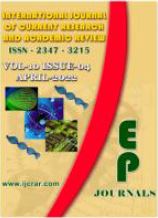Abstract Volume:10 Issue-4 Year-2022 Original Research Articles
 |
Online ISSN : 2347 - 3215 Issues : 12 per year Publisher : Excellent Publishers Email : editorijcret@gmail.com |
Anti-nutritional factors are compounds which reduce the nutrient utilization and/or feed intake of plants or plant products used as animal feeds. Numerous Anti-nutritional factors (ANFs) in feeds can cause toxicity in livestock. The major anti- nutrients found in livestock feed sources are tannins, saponins, cyanogenic glycosides, phytic acid, oxalates, protease inhibitors, gossypol and mycotoxins. Tannins are heat stable and they decreased protein digestibility in animals, probably by either making protein partially unavailable or inhibiting digestive enzymes and increasing fecal nitrogen and responsible for decreased feed intake, growth rate, feed efficiency and protein digestibility. Saponins can affect animal performance and metabolism through erythrocyte haemolysis, reduction of blood and liver cholesterol, depression of growth rate, bloat (ruminants), inhibition of smooth muscle activity, enzyme inhibition and reduction in nutrient absorption. Oxalic acid on the other hand binds calcium and forms calcium oxalate which adversely affects the absorption and utilization of calcium in the animal body. Phytic acid forms protein and mineral-phytic acid complexes and reduces protein and mineral bioavailability, inhibits the action of gastrointestinal tyrosinase, trypsin, pepsin, lipase and amylase. Gossypol pigment in cottonseed occurs in free and bound forms. Free gossypol is the toxic entity and causes organ damage, cardiac failure and death. Alkaloids are one of the largest groups of chemical compounds synthesised by plants and generally found as salts of plant acids such as oxalic, malic, tartaric or citric acid. Mycotoxins are toxic secondary metabolites produced by fungi toxic to livestock and plants and heir ingestion, inhalation or dermal absorption may cause different diseases and even death. Protease inhibitors are the most commonly encountered class of ant nutritional factors of plant origin which have the ability to inhibit the activity of proteolytic enzymes within the gastrointestinal tract of animals. A number of methods can be employed to reduce the toxic effects of ant nutrients in animal feed.
How to cite this article:
Chala Edea. 2022. Anti-Nutritional Factors in Livestock Feed, Effect on Animal Performance and Methods of Mitigation. A Review.Int.J.Curr.Res.Aca.Rev. 10(4): 119-129doi: https://doi.org/10.20546/ijcrar.2022.1004.010



Quick Navigation
- Print Article
- Full Text PDF
- How to Cite this Article
- on Google
- on Google Scholor
- Citation Alert By Google Scholar
